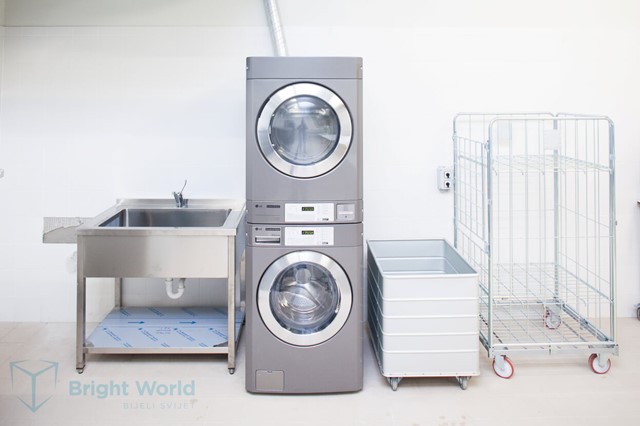Hygiene is a natural and necessary part of the health care institutions’ workflow, including hospitals, care homes, nursing homes, or polyclinics. However, the duty to remind ourselves of its key role is never more important than today. Although care for hygiene is these objects’ job description, making sure the number of patients is small as well as shortening the recovery process of patients is in the best interest of us all. Correct care for hygiene offers solutions to these problems, but it cannot be complete without adequate care for laundry.
Recommended equipment for health institutions
In health institutions and nursing homes, laundry is practically all - present – from uniforms, bedsheets, surgical equipment, mops, etc. Laundry is also a potential carrier and transmitter of various infections, which is why special measures of hygienic treatment need to be implemented, especially when it comes to high-risk spaces in which people are medically treated and cared for.
To achieve the optimal level of hygiene, washing, and drying laundry in hygienic professional washers and dryers is essential. LG professional washers are designed precisely to achieve and maintain hygiene, with its three main features – new technologies such as Wave force and Auto tub clean are programs with powerful water waves which maintain maximum cleanliness of the washer during the wash cycle, antibacterial design, that is, the antibacterial coating which prevents the retention of bacteria and viruses, and special hygienic program which decontaminates laundry during the washing process. In cases of big hospitals that require washing and drying large quantities of laundry, we recommend Electrolux industrial laundry washers and dryers.
But professional washers are not the only ones preventing the spreading of bacteria and viruses – professional dryers are an excellent ally in this struggle against them because the dryers’ high temperature helps kill bacteria and viruses.
Sorting of laundry
European norm number EN1406 recommends sorting dirty laundry into colored bags: one bag of one color for big flat laundry such as sheets, another bag for small flat laundry such as pillowcases, aprons, hospital clothes and such, another bag for laundry intended for dryers and yet another one for another laundry. Using adequate protective equipment while collecting and sorting laundry is such as aprons and gloves, is mandatory, while uniforms for employees and other high-risk laundry is to be excluded from this sorting process.
Although health institutions and other facilities which care for the elderly, as it’s well known, favor hygiene above everything else, the pandemic rendered us all confused and in doubt, despite having medical knowledge. To give the maximum amount of protection for your patients, gathering information on all aspects of hygiene is crucial.

Advice for washing and drying
To keep hygienic standards to a maximum and to give it consistency, adhering to certain rules regarding the handling of laundry equipment is necessary. For example, it’s important to physically separate washers from dryers to prevent clean laundry from coming into contact with dirty.
Another thing worth noting is that, although detergents certainly contribute to maintaining hygiene, adjusting its dosage to the level of contamination is critical. Furthermore, if you are using bactericides, it’s preferable to wash laundry at 60°C or lower, and if you are not using them, then laundry needs to be washed at the temperature of 75°C up to 90°C. Textile families mustn’t be washed together, and that means that washing two articles which require different finishing processes must be avoided. For example, a pillowcase goes on the ironer after washing, and a towel goes straight into the dryer. These are two different post-wash processes.
When it comes to drying, the dryer temperature needs to be adjusted to the type of fabric. It’s also necessary to make sure the drum of the dryer is not overloaded, and this goes for the washer as well. If the laundry is intended for ironing, it mustn’t be dried too much, because that will require dampening the fabric all over again. It’s also advisable not to leave hot laundry in the dryer overnight; it’s much better to dry it the next morning.
Transport
The way of transporting laundry isn't’ any less important than washing or drying. Since clean laundry needs to be separated from dirty in the process of washing and drying, so too the transport needs to have two different routes – one for the clean, and another for the dirty laundry. It’s also vital to adequately cover the laundry to avoid potential risks.
If you need our fighters for health, contact us here.


